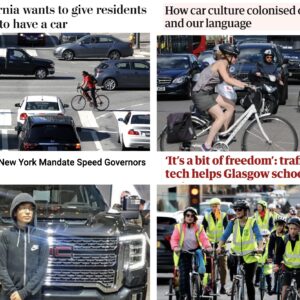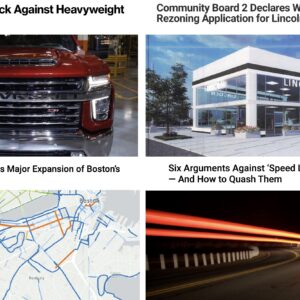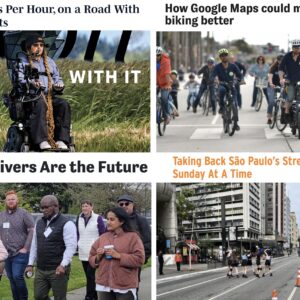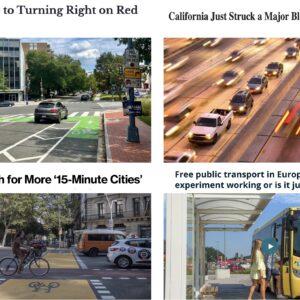Helmetless in the holy land, mountain bikes in Seattle, two-wheeled EMTs, carfree babies, how women park, Caribbean cargo trikes, and royal disapproval
Here’s the news that caught our eye this week:
– “There were just too many cars for the system,” was how an ODOT representative explained the worst car traffic backups that Portland has ever seen after an unexpected weekday afternoon snowstorm last week left 4 inches of snow on the ground just in time for the evening commute.
– Distracted driving is the new drunk driving, and a growing number of states are joining the charge led by new transpo sec’y LaHood to curb all manner of driving while texting and talking on the phone — though few are even discussing a crackdown on hands-free cell phone use.
– Communities across the US are starting to follow Virginia’s lead in eliminating cul-de-sac development. This article makes the case for why grid streets are safer and less of a drain on municipal resources and public goods.
– Israel is one of the few countries in the world with a mandatory, all-ages helmet law for bicycling. The government is considering legislation that would allow helmetless riding within cities.
– Portland could learn a lot from Seattle’s urban mountain bike skills park that lives happily under one of its freeways.
– A town in England has been successfully experimenting with a team of bicycle-mounted paramedics.
– A blogger has unearthed a decade-old Chinese language bike map for Toronto, and urges cities to look at their demographics and produce more multi-lingual materials.
– Why drive — or bike — when you can walk, asks the Oregonian’s editorial board in a moment of clarity.
– A San Francisco man spent a year without getting in a car, and lived to blog about it.
– You don’t need a car to have a baby, says this Portland couple, shown here getting a pedicab ride home from the hospital with their newborn.
– Ever wondered what the street in front of your house or school or office or business would be like without cars for a day? Here’s a primer for how to make that happen, recently re-published on the web.
– Take a ride into the little-explored world of the gendered psychology of parking.
– Our colleagues over at Bike Rumor took a cruise through the Caribbean and documented the bikes and bike culture they found there.
– In the category of things to read online instead of working today, we present to you the tour diary of two young women who biked halfway across the country in the late 1940s.
– Video of the week: Prince Charles expresses dismay at car-oriented development.







Thanks for reading.
BikePortland has served this community with independent community journalism since 2005. We rely on subscriptions from readers like you to survive. Your financial support is vital in keeping this valuable resource alive and well.
Please subscribe today to strengthen and expand our work.
I won’t be sad to see cul-de-sacs go by the wayside. Figuring how to get out of neighborhoods that have them sometimes wastes time and energy, and…cul-de-sacs sometimes ruin the opportunity for great bike routes that would avoid heavy motor vehicle traffic. I imagine though, that residents on cul-de-sacs really appreciate that designs ability to eliminate ‘cut-through’ traffic.
So the trick in reverting to a conventional grid, is to create a street design that allows connectivity but manages traffic so as to establish a good measure of the quality of life residents seek in choosing to live on a cul-de-sac.
link
I don’t mind cul-de-sacs, if they have a through-route for nonmotorized traffic to the next block on the other side. Let the motorists get inconvenienced while everyone else can just jet through between houses.
The mountain bike skills park is neat. Beaverton used to have one behind the Beaverton School District office, but then they paved it and banned mountain bikes in it. Shame on Tualatin Hills Parks for that boneheaded move.
“Moment of clarity” — nice turn of phrase, Elly. Far too rare, though, coming from the Oregonian. I thought they’d tell us why the snowstorm really proved why we need a 12-lane bridge, or something.
The so-called “quality of life” that people perceive in a cul-de-sac neighborhood is illusory. It’s not just the cul-de-sac, per se; it’s the housing development that has one access point to the outside world, and curvy streets that all branch out into these bloated dead-ends, but all the developments connect onto a four-lane feeder road that has vehicle speeds completely incompatible with walking or biking. If your kid has a friend in the adjoining — yet unconnected by any direct route — development, and your houses are a few hundred feet apart, it still means a car trip for one of the parents so that the little tykes can get together on their “play date” tossing a ball around in that circle (but more likely tossing a virtual ball around with the Wii, indoors, in the “media room.”
Even when the houses are as densely packed on top of each other as in an older neighborhood, there’s such little interconnection that residents are utterly isolated without their cars.
I wonder if the state of Virginia may try to restore through routes, at least for pedestrians and bike travel in some developments equipped with cul-de-sacs. It seems as though doing this could be complicated and controversial. I think in some instances though, it could be worth the effort.
Houses might have to be removed to make way for the route. Adjoining neighbors might be up in arms about the public being able to freely pass through their area.
If it could be shown to them that such a route enabled a quick little walk or bike ride to the corner store, rather than a ‘get in the car, drive out in the busy traffic’ to get there’, the benefit of the route might come to be seen as outweighing possible downsides.
I caught this from an article on Fidelity’s web site titled “5 Financial Truths for 2010”. Apparently global economic growth boils down to driving more:
Mature markets like the United States and Japan simply don’t have the growth potential other countries do, says Douglas Rice, a personal finance educator and author.
“There’s simply more demand and more room for developing countries to grow,” he says. “In China as of 2008, there were only 50 people out of every 1,000 with cars. In the U.S., for every 1,000 people, 765 owned cars. Americans will need to replace their cars eventually, but that’s a totally different demand curve than pushing out millions of new drivers every year.”
Peejay you just described my 1950’s neighborhood here in Santa Clara, California. Add to that the gas station on one corner and strip mall opposite corner flanked by drive-through espresso stand and you’ve got one of the scariest walks to the library or park you could imagine. My elderly Mom was down visiting recently and nearly got hit on almost a daily basis.